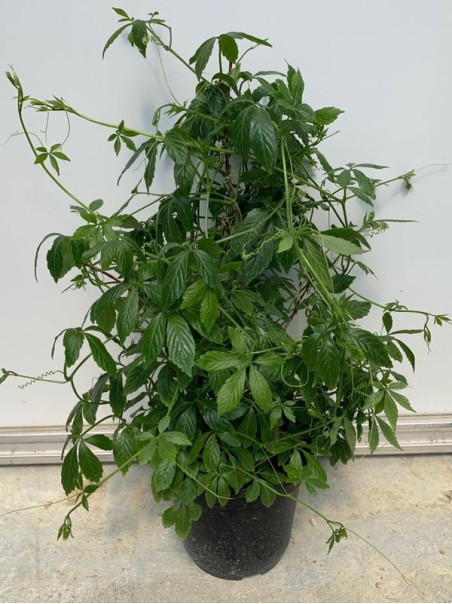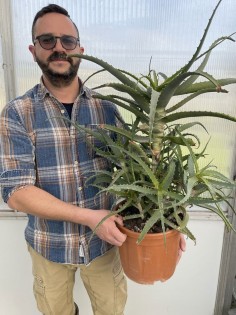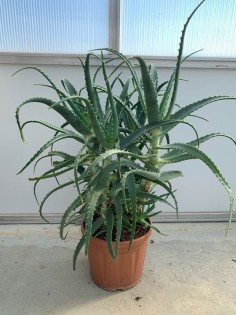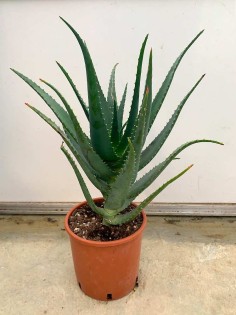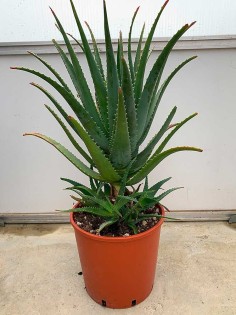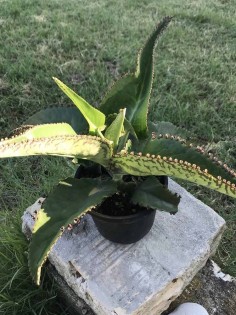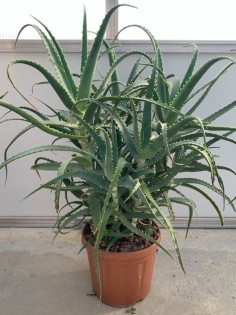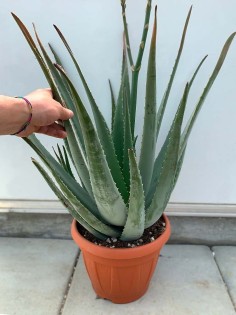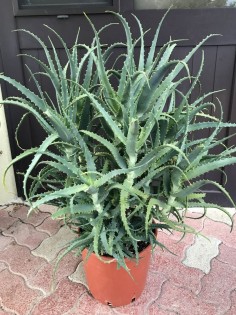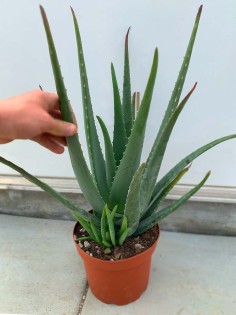GET A 10% DISCOUNT VOUCHER
Gynostemma pentaphyllum Plant, 'Jiaogulan'
 23 Number of reviews:
23 Number of reviews:
Description
![]()
![]()
![]()
![]()
![]()
The Gynostemma is a plant of Asian origin that can also be grown in our country. In traditional Chinese medicine the leaves are considered a powerful adaptogen like ginseng, so much so that the plant is also called "Southern Ginseng".
- We use the leaves eaten raw, or as herbal tea
- 20 cm jar of 4.3 liters
- Cultivated in a healthy environment
- Height not defined, as being a natural product growth can vary according to various environmental factors
- Any aesthetic defects are not to be considered defects, but qualities that demonstrate the naturalness of the crops
Gynostemma pentaphyllum, plant
All the plants of Gynostemma pentaphyllum , sold by me, are grown in the open air, in a shady environment (the plant does not love much sun). The plants are rigorously cultivated with natural methods, without the use of herbicides, pesticides, or chemical fertilizers.
Description
Gynostemma pentaphyllum is a perennial herb with a climbing habit, which is part of the same family as cucumbers and watermelon (the Cucurbitaceae). It grows spontaneously in the south-east of China, on Mount Fanjing, in a cool-humid climate, but is easily cultivable even in our country.
The innumerable beneficial properties of this plant were known since ancient times and was used in the days of the Ming dynasty (1300 BC). In ancient Chinese medical texts it is referred to as a miraculous plant or "the herb of immortality" or eternal life. It has several vulgar names, the most common is Jiaogulan, but it is also referred to as Makino, Xiancao, which means "immortal herb", or "Southern Ginseng" for its chemical composition similar to ginseng but with very different properties.
Gynostemma properties
This plant has many medicinal properties, which make it useful for a very high number of disorders.
Active ingredients : it is described in various texts as one of the most valid adaptogens, with anti-aging effects and increased physical strength (vitality). As evidenced by the pharmacological studies conducted on the raw extracts of Gynostemma. The ability to stimulate the immune system is due to the numerous triterpenic saponins, to the different flavonoids and gypenosides that counts in its phytocomplex.
Properties :
- Anti-inflammatory : this is perhaps one of the most interesting properties of this plant, able to reduce the pain caused by chronic inflammatory diseases, or autoimmune.
- Adaptogen : the adaptogenic plants increase in a non-specific way the resistance, the capacity and the defenses of the organism, stimulating it to react positively to stressful situations; situations that can be variously interpretable, such as stressful events of a physical or emotional nature. The Gynostemma is a very powerful adaptogen comparable to the more famous Korean Ginseng and Ganoderma lucidum (Reishi).
- Immunostimulant : this plant improves the body's immune response to external agents and to the attack of viruses and bacteria
- Anti-age : The gypenosidi present in the Gynostemma can counteract the free radicals that affect our body, carrying out an important anti-aging action.
- Reduces bad cholesterol and triglycerides : Gynostemma has a positive effect on lipid metabolism, facilitating the reduction of blood fat levels and therefore of deposits in blood vessels. This means that it is a plant suitable to counteract the formation of plaques that cause arteriosclerosis. In addition to acting on lipids, the saponins present in the extracts of this plant have shown the ability to reduce the levels of "bad" cholesterol in favor of the "good" one.
Other Gynostemma properties
- helps fight stress;
- reduces migraine;
- increases liver function in patients with liver disease;
- fights gastrointestinal disorders;
- improves memory and brain functions;
- improves sexual performance;
- controls the blood sugar (blood sugar levels) of people with diabetes;
- reduces the growth and spread of cancer cells.
Use
leaves are used for this plant.
Gynostemma leaves can be eaten fresh, alone or mixed in salads. Or they can be used as an infusion, both as fresh and dried leaves.
How to make Gynostemma tea : take 8-9 fresh leaves (or a teaspoon of dried leaf powder) for a cup of water boiling. It is left to infuse for about 10 minutes and then filtered and drunk.
Contraindications
Although the Gynostemma is considered among the safest herbal supplements, there are some possible side effects that you should be aware of. Gynostemma should not be taken by pregnant women and people taking anticoagulants or with coagulation disorders.
How to grow the plant
Here are some tips for growing and growing the Gynostemma pentaphyllum plant. Even if it comes from the East, it is a very simple plant to keep, even for those who do not have a green thumb.
Choosing the type of Terrain
The soil should be rich in organic matter, dissolved and well draining.
Sun exposure
The ideal environment for the growth of this plant is mountain, fresh and above all wet. Therefore, if you try to cultivate it, it is best not to keep it in full sun, on the contrary guaranteeing it a totally shady position.
Irrigation
Especially in hot and dry periods the Gynostemma plant needs daily irrigation. For perfect growth the soil should always be a little wet.
In the winter months
It tolerates periods of intense cold, while it can suffer in hot and dry periods, especially if kept in full sun and if it is not watered every day.
For more information on Gynostemma, I recommend watching this video interview with Joe Hollis, an American botanist who is expert in the cultivation and use of medicinal plants and in particular of making herbs part of ancient Traditional Chinese Medicine.
PIANTA_GYNOSTEMMA_16
New
Markolux

07/02/2024
Gynostemma pentaphyllum
pianta arrivata in ottime condizioni, facile da curare e molto efficace per la glicemia e la fluidificazione del sangue, a me che non ho particolari problemi e la pressione tendenzialmente bassa , ne bastano poche foglie al giorno
raffaella G.

05/29/2023
Raffaella
Il prodotto è arrivato ben impacchettato e la pianta è come sempre meravigliosa Azienda sempre seria e attenta nei dettagli
Carla B.

05/15/2023
OHOH
Ne devo ancora studiare le proprietà, per ora cresce ed abbellisce il mio davanzale in attesa di un vaso in terracotta come le sue vicine.
stefania C.

07/25/2022
PIENA SODDISFAZIONE!
arrivata in tempi brevi e integra in un imballo fatto a regola d'arte!Straconsigliati, bravi!!!
raffaella G.

06/16/2022
Raffaella
La pianta è arrivata perfetta Ottima azienda !!! Sempre soddisfatta
Giovanni C.

12/23/2021
Pianta bella e buona
Non conoscevo la gynostemma, nè le sue virtù. per ora l'ho messa in vaso grande esposta a est, spero resista. Aspetterò che la pianta cresca un po'.
Stefano S.

12/17/2021
Ottimo trasporto
Ottimo l’imballaggio della pianta durante il trasporto. Ora aspettiamo il risultato in vaso tenuto all’interno.
Giovanni P.

12/02/2020
Personale
Tutti i prodotti ricevuti sono ottimi , al momento sono rimasto soddisfatto, la ringrazio della disponibilità
Samuele M.

11/27/2020
Soddisfatissimo :-)
Sono molto soddisfatto,molto bella come pianta e come e' stata curata,Grazie :-)
Aurelia P.

10/30/2020
Pianta di Gynostemma
Pianta arrivata in perfette condizioni. Grazie
.

10/26/2020
ottimo
buon imballaggio ,spedizione celere ed efficiente,la pianta al suo arrivo aveva un po' di sete,come normale,consigliati acquisti
Giuseppina M.

10/22/2020
Pianta Gynostemma
Una pianta rigorosa
Paolo C.

09/28/2020
Arrivata perfetta
Nonostante il trasporto la pianta è arrivata non danneggiata e ancora in perfetto stato di freschezza.
Olta L.

09/26/2020
in ottimo stato
arrivata in ottime condizioni
PAOLA R.

08/05/2020
Bellissima pianta
Pianta arrivata in ottime condizioni grazie
PATRIZIA B.

07/22/2020
Pianta di Gynostemma
La pianta Gynostemma funziona veramente.Ottima più della tisana
maria luisa R.

06/05/2020
Pianta
Veramente bella
Mauro R.

06/03/2020
Pianta officinale
pianta in ottime condizioni, consegna velocissima, ottimo acquisto
Oana P.

05/16/2020
Grazie per la cura e l'attenzione
Piantina molto bella, arrivata molto rapidamente, imballata con molta cura ed attenzione, grazie Mauro
Antoet A.

08/30/2019
Gynostemma
Arrivata ben imballata, senza patimenti e nei giusti tempi. Soddisfatta
Angelo R.

08/21/2019
Pianta Gyn pent
mi ritengo soddisfatto per la tempestività e la cura con cui è stato evaso l'ordine. servizio
valenpino V.

08/07/2019
Pianta
Cresce molto velocemente
Rosario Giovanni M.

08/02/2019
Ultimo acquisto
Persone meravigliose puntuali e precise nella spedizione.Li ho consigliati a mio cognato che ha acquistato da loro.Consigliatissimi

